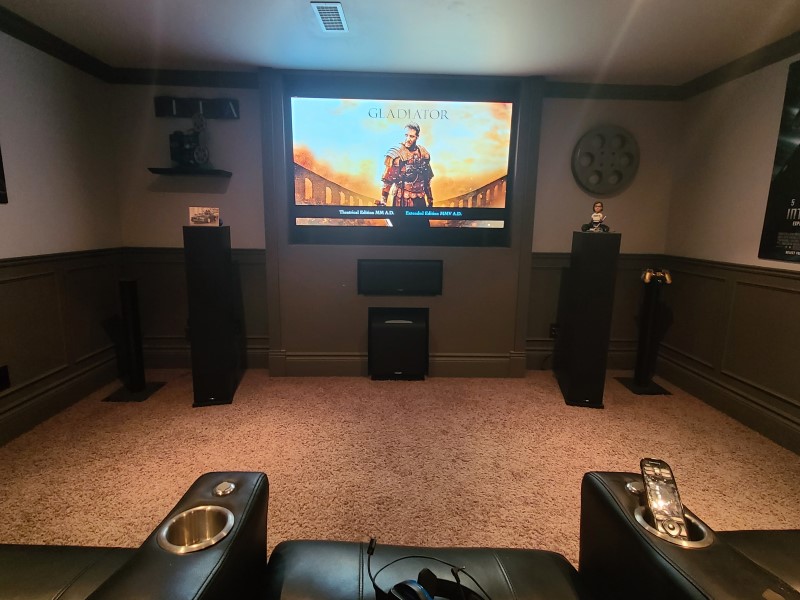Will Moving your Center Speaker Up Make a Big Difference?
If you dare to post a picture of your home theater or cinema area set up on the Internet, you’ll immediately get flooded with (usually) unwanted and unasked for advice. Speaker placement, display height, wall color, and any number of other things will be suggested. One of the most common is center speaker height. If your center speaker isn’t tucked directly under your display, you’ll get a chorus of suggestions to move it up. But will moving your center speaker up really make that big of a difference?
Answer: Nope.
This is easy enough to test in real life. Just shove a couple of books under your center and see if it makes a difference. But more than that, does it sound like voices are coming from below your display? If not, you don’t need to move your speaker, no matter what the Internet says. But let’s get into the reasons.
Why People Suggest you Move Your Center Speaker Up
There are things called “best practices.” These are practices that, given no other constraints, are the best way to do a thing. With a display, the best practice is for it to be placed not too high. It should be facing out as well. One of those is more important than the other. Can you tell which is which? The too high can make viewing the display slightly uncomfortable. The facing out? Well, if you don’t do that you’ve got some real problems.
The best practice for a center speaker is for it to be tucked directly below your display so that the voices (that primarily come from the center speaker) are securely anchored to the image. If someone sees even a hint of daylight between the top of your center speaker and the bottom of your display, they suggest you move it up. Why? Because it is technically correct. But in actual use, it makes very little sonic difference.

Your Brain and Your Center Channel
Your brain does a fantastic job of tricking you on a daily, if not moment-to-moment, basis. Our eyes don’t see a continuous image from the real world. It’s more like 60 frames per second. But our brains stitch all that into a continuous image. Your brain is very good at making things make sense. Don’t believe me? Watch a martial arts fight in a movie, and then re-watch it with the sound off. Suddenly, what looked like bone-crushing punches clearly miss. Why? Our brains.
When the lips move on a character or the action on the screen matches with the sound we hear, if the sound source is physically close, our brain “puts” the sound in the screen. That’s why all the suggestions for moving the center speaker up are usually met with, “Umm…why?” The owner never noticed a problem and is now wondering if they should have. Nope, you didn’t and you won’t. If you can move the speaker up, go ahead. But sonically don’t expect a difference.
Proper Center Channel Placement
Moving your center speaker up a couple of inches or even a foot is unlikely to make much of a difference. But there are some things you should watch out for. If you’ve placed your center speaker on a shelf (or in a piece of furniture), make sure it is pulled as far forward as possible. You want to get the front of the speaker (not the front of the grille, but the speaker) at least in line with the front of the shelf. If you can pull it a little over the edge, do that. Pushing the speaker back allows the sound to bounce off the shelf and can create intelligibility issues.
If your center is rear-ported, making sure it is not pushed up against a wall is also advisable. If you can’t give it room to breathe, then put a good amount of absorptive material behind it. We have an entire article on how to fix in-cabinet placements. Check that out for additional ideas.
What About Non-Traditional Center Channel Placements?
People often have to deal with non-optimal rooms and placements. Too often, the display is placed without much thought as to where a center channel will go. Or even if speakers will be integrated at all! You end up with people asking if they can place their center channel above their display rather than below. The chorus of “No” online makes me cringe. The fact is that your brain is just as adept in relocating a sound that emanates from slightly above a screen to the screen as it is from a speaker placed below the screen. If the only place you have for your center channel is above your screen, that’s the place it has to go. You’ll quickly find out if it “works” or not once you start watching. The vast majority of the time, it will be just fine.
Conclusion
People like to be helpful. More than that, they like to show that they have some knowledge about a subject. But moving your center speaker up is one piece of advice that generally isn’t needed and doesn’t make much of a difference. If you are not noticing a problem, you don’t have one. This is one time you can definitely trust your ears.


